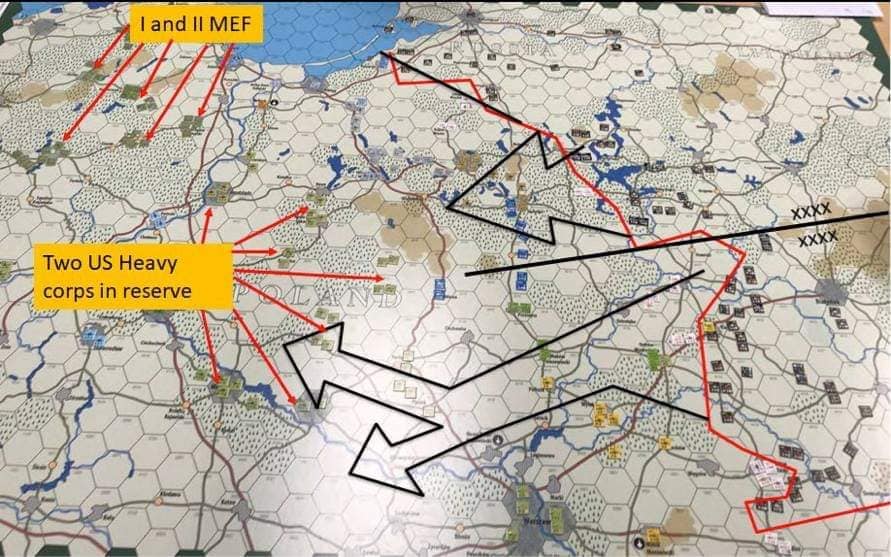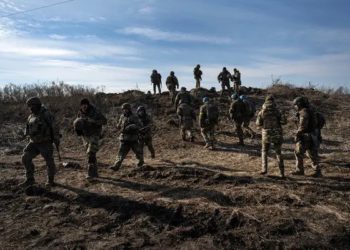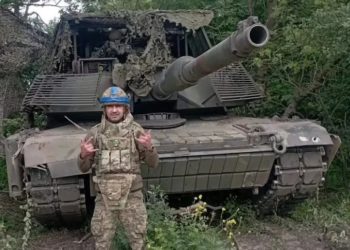2019 War Game: US vs Russia, China, and North Korea… Simultaneously!

Dr. James Lacey is a Professor of Strategic Studies at the Marine Corps War College. In 2019, he organized an interesting war game for his students: He created a Russian team, a North Korean team, and a Chinese team. Those would be faced by Taiwan, Indo-Pacific Command (Korea conflict), and European Command.
He gave the US team £200 billion, while the Russian and Chinese teams had to share another £200 billion. Teams could spend that money on whatever they wanted (75 items to choose from). They could invest in new carriers, more combat brigades, various other weapon platforms, spend money on diplomacy, or spend money on R&D to try and develop new technologies. He also gave them eight years to get ready prior to the conflict.

Conflict Scenarios and Initial Strategies
Obviously, the Russians are the bad guys and they invade the rest of Ukraine and all three of the Baltic states before starting to lust all over Poland. As the US armed forces react to this situation, Beijing takes advantage of Washington being distracted to launch a full-on assault on Taiwan. Pyongyang takes its cue and invades South Korea. How did it play out?
Well, the US had to make choices as they do not have the resources to fight in all three theaters at once. The US focused the bulk of its ground troops and air force in Europe, while most of its Navy assets were deployed against China and North Korea. Some US ground units made it to South Korea (2 infantry divisions and 2 Marine regiments), but overall, Taiwan and South Korea were left to fight their respective ground wars alone. The Russians would face most of the US air assets, as well as 8 Army Divisions and most of the Marine Corps and the rest of NATO.
Korean Theater
The North Koreans initially attempt to bypass Seoul and quickly break through the South Korean lines. However, the arrival of US forces helps the South Koreans establish a new defensive line. The North Koreans then shift their focus to Seoul. The fighting there becomes very intense: North Korea can only sustain 10 days of war operations and cannot afford to be behind schedule. As the North Koreans stall, China intervenes by sending two armies into that theater. Pyongyang, desperate for results, deploys chemical weapons, causing tens of thousands of military casualties to South Korean and American units. The INDOPACOM commander, under pressure, requests authority from Washington to use nuclear weapons.
Taiwanese Theater
The Chinese invade Taiwan but are hampered by US air operations. The Taiwanese forces, reinforced by Japanese units, retreat toward Taipei and the mountainous area inland where they settle into defensive operations. They are not strong enough to expel the Chinese, but the Chinese can’t bring in enough reinforcements to gain the advantage due to the US air operations. However, the Americans do not gain complete local air superiority as their carriers are held back, staying out of range of the Chinese intermediate-range missiles. US assets can operate from South Korean and Japanese airfields. The Taiwanese are forced to wait for more US reinforcements, which depends on the situation in the other theaters of operations. The Chinese troops on the Taiwanese beachheads are in the same situation and have to wait for more Chinese forces to reinforce them.
European Theater
US and NATO troops establish a solid defensive line from where they want to counter-attack en masse. But the Polish high command refuses to pull its troops back and trade space for time. As a result, the Polish armed forces crumble under the weight of the Russian assault. As Russian forces break through the Polish lines all along the front, the US commander must abandon his idea for a concentrated counter-attack and instead commit his forces piecemeal to plug the gaps. While those actions slow the Russians down, it also dilutes NATO units’ overall strength. The result is 60,000 NATO casualties on the first day of the conflict. The 1st US Cavalry and 1st US Armored Division counter-attack the Russians in the South. This move cost US and Russian units a 50% loss rate in 72 hours. After several days of intense fighting, NATO retakes the advantage and starts pushing the Russians back. The Russian commander requests his leadership for the authority to release nuclear weapons.
Conclusion of the War Game
US carriers are vulnerable to Russian and Chinese missiles. As such, their effectiveness, when they are held back, is diluted at best. The poor grunt fighting the land war might have little air support initially, as all air forces involved first try to gain air superiority over the battlefield. So for the initial few weeks, the air war and land war seem almost completely disconnected from one another. NATO is politically fragmented. Several of its members had to be convinced to take up the fight against Russia to defend the Baltic states and Poland. The US does not have the necessary infrastructure and logistics to sustain a long-term high-intensity war against a peer adversary situated on the other side of the globe. US commanders did not have an answer to counter the Russian or Chinese use of massive fire complexes, and neither did they have useful tools to counter North Korean chemical weapons. Most importantly, the US and its allies suffered 150,000 casualties in the first week of fighting. That’s several brigades lost every day. All actors burned through their reserves in both men and machines at a tremendous rate. Modern high-intensity fighting looks strangely like WWI, from the casualty rates point of view. This attrition rate is simply not sustainable in the medium to long term. Not for the Americans, not for the Russians, not even for the Chinese. As such, every theater commander ended up requesting authorization to use nuclear weapons within weeks of the start of the war. A war between Russia and the US or China and the US would very quickly escalate from a small localized clash to total war.
While a war game is just a simulation, this particular one is interesting as far as results go: Three years after this was released, the war in Ukraine erupted, and some of the findings from 2019 came back to haunt decision-makers, journalists, and bloggers alike.
-RBM










